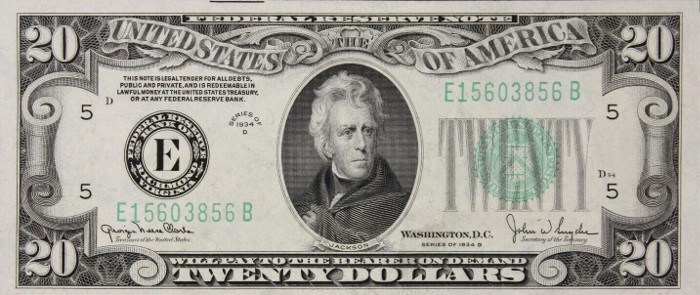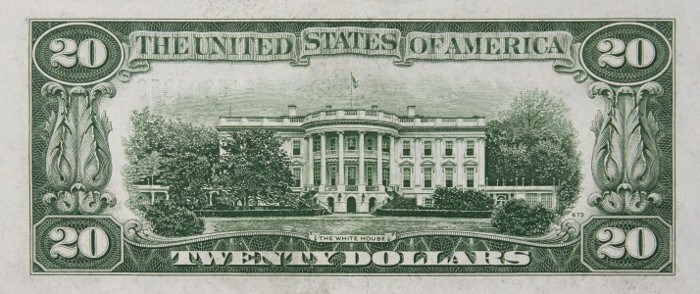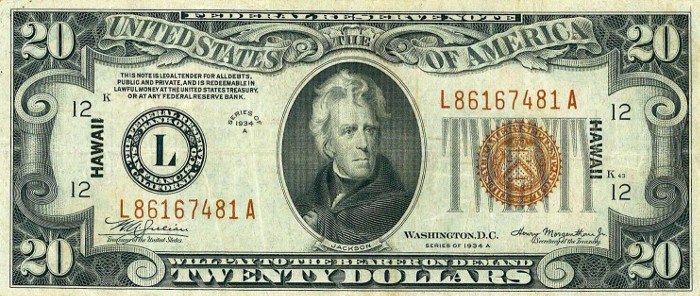The 1934 twenty dollar bills can be valuable depending on the series. Star notes and Hawaii notes were printed and they can be worth a lot more than the standard notes. Keep reading to learn more about these bills.


Specifications
| Denomination: | $20.00 USD |
| Type: | Federal Reserve Note |
| Portrait: | Andrew Jackson | Series: | Five: 1934, 1934A, 1934B, 1934C, 1934D |
Value
The value will depend on the series and the bill's condition. Star notes will sell for higher prices.
The 1934 series $20 bills are worth around $27.50 in very fine condition. In extremely fine condition the value is around $50. In uncirculated condition the price is around $115 for bills with an MS 63 grade.
The 1934A series $20 bills are worth around $25-27.50 in very fine condition. In extremely fine condition the value is around $50. In uncirculated condition the price is around $85 for bills with an MS 63 grade.
The 1934B series $20 bills are worth around $27.50 in very fine condition. In extremely fine condition the value is around $40. In uncirculated condition the price is around $100 for bills with an MS 63 grade.
The 1934C series $20 bills are worth around $25 in very fine condition. In extremely fine condition the value is around $35. In uncirculated condition the price is around $70-75 for bills with an MS 63 grade.
The 1934D series $20 bills are worth around $25 in very fine condition. In extremely fine condition the value is around $35. In uncirculated condition the price is around $95 for bills with an MS 63 grade.
Star Notes
Star notes are replacement bills that the United States Federal Reserve printed. These star notes are more rare and thus more valuable. You can tell if you have a star note by looking to see if there is a star symbol at the end of the serial number.
The 1934 series $20 star notes are worth around $85 in very fine condition. In extremely fine condition the value is around $150. In uncirculated condition the price is around $650-675 for notes with an MS 63 grade.
Most 1934A series $20 star notes are worth around $75 in very fine condition. In extremely fine condition the value is around $150. In uncirculated condition the price is around $350 for notes with an MS 63 grade.
Most 1934B series $20 star notes are worth around $125-175 in very fine condition. In extremely fine condition the value is around $200-225. In uncirculated condition the price is around $650 for notes with an MS 63 grade. Star notes issued from the Federal Reserve Bank of Dallas will be more valuable.
Most 1934C series $20 star notes are worth around $80-100 in very fine condition. In extremely fine condition the value is around $125-150. In uncirculated condition the price is around $400-450 for notes with an MS 63 grade.
Most 1934D series $20 star notes are worth around $110-130 in very fine condition. In extremely fine condition the value is around $175-225. In uncirculated condition the price is around $500-625 for notes with an MS 63 grade.
Note: Valuable bills should be placed inside currency holders.
Hawaii Notes

There are 1934 and 1934A series $20 Hawaii notes available. On these bills the word Hawaii is clearly printed on the left hand side of the bill and on the entire back of the bill. Each note has a brown seal.
This was an overprint that was issued as a response to the Pearl Harbor attack. The theory was that if Japan took over Hawaii then they would capture a lot of US currency. If that happened then the US government would declare any Hawaii stamped note to be invalid.
The 1934 series $20 Hawaii notes are worth around $125 in very fine condition. In extremely fine condition the value is around $300. In uncirculated condition the price will be around $2,000 for notes with an MS 63 grade.
The 1934A series $20 Hawaii notes are worth around $125 in very fine condition. In extremely fine condition the value is around $195. In uncirculated condition the price will be around $750 for notes with an MS 63 grade.
Hawaii star notes are available and they are rare. Each star note can sell for thousands of dollars in the better condition grades.
Grading System
Very fine- A note that has been in circulation but not for a long time. The note is still relatively crisp. There may be some creases, folds, or light smudges.
Extremely fine- A note that shows small signs of having been in circulation. The note will be bright and it will have almost all of its original crispness. There might be one or two minor creases or folds but there are no stains, discolorations, or tears.
MS 63 choice uncirculated- A note that shows no signs of ever having been in circulation. The note still has its original crispness. The note is also well-centered.
Sources:
A Guide Book of United States Paper Money
See also:
